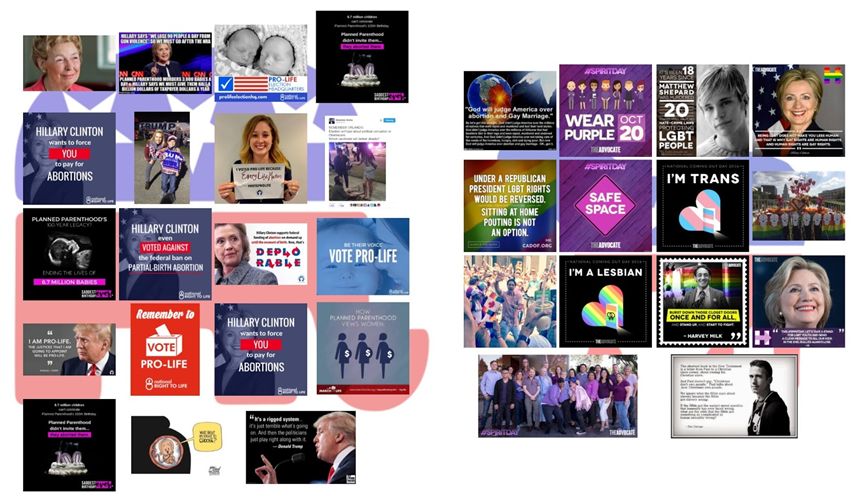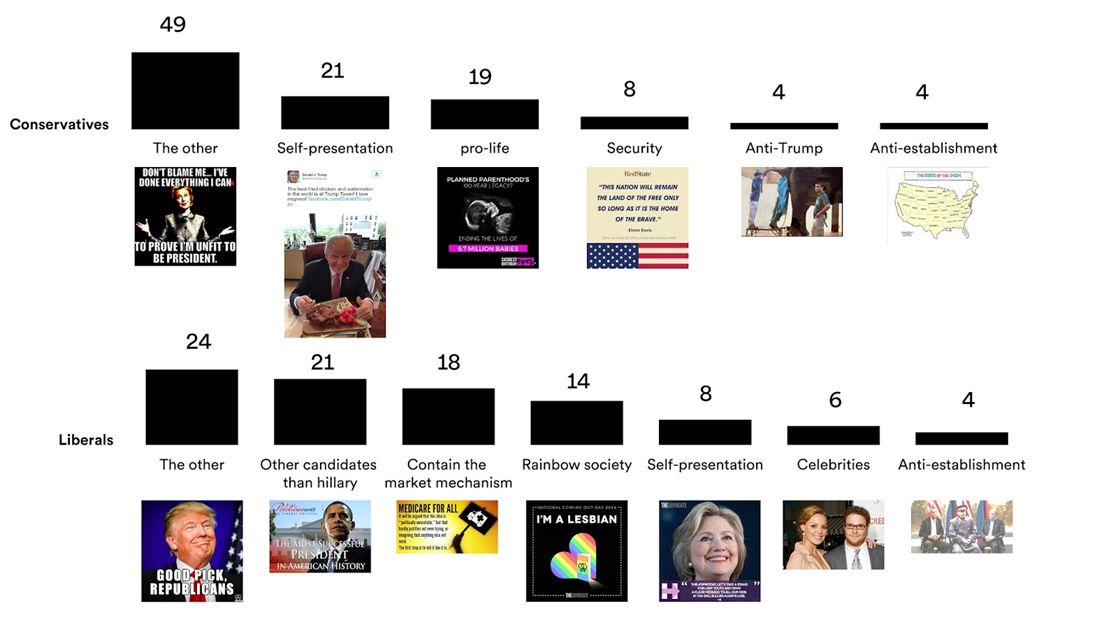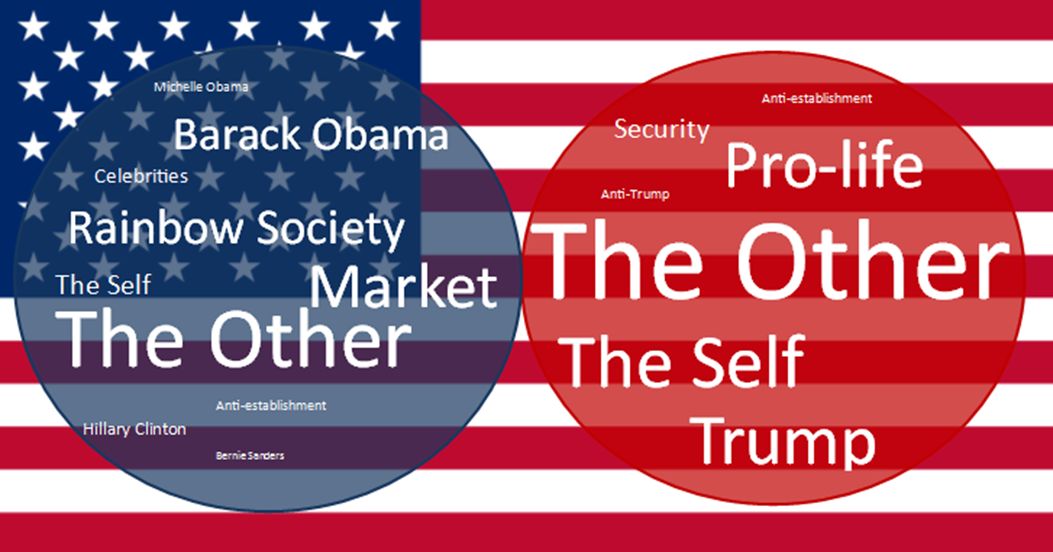On January 20th, Donald Trump was inaugurated as president of the United States of America. According to a lot of journalistic analysis, Trump would never have become so popular without the Trump-bubble on social media such as Facebook. This theory calls for research on how filter bubbles look like.
A filter bubble means that Facebook gives you content that is based on your past clicks and likes. This means that once you start following pages that are pro-Trump and you don’t follow pro-liberal pages, you will only see positive posts about Trump. The Wall Street Journal Blue Feed, Red Feed project shows two Facebook feeds based on the news shared by well-known liberal and conservative media.
On these feeds, not only news and texts are posted, but also a lot of images. Those images give a very strong view of what people who like these pages are concerned with. By analyzing those images on the liberal and conservative pages, it can be analyzed whether there exists a filter bubble on both sides of the political spectrum, and how they do look like. When the images on both sides differ a lot, you can speak of filter bubbles. This research shows that this is the case. The kind of images that are popular on both sides determine how the bubbles look like, based on images. This article gives you an insight in this.
During the Digital Methodes Initiative (DMI) 2017, students of the MA Journalism and Media and of the MA New Media and Digital Culture collected data in order to be able to give the liberal and conservative bubble ‘a face’, a general image. Therefore, the most engaged, most liked, shared and commented, images shared or posted by several liberal and conservative Facebook pages were analysed.
| Most conservative Facebook Pages | Most liberal Facebook Pages |
| Young Conservatives | CommonDreams |
| National Right to Life | The New Civil Rights Movement |
| Glenn Beck | Jezebel |
| LifeNews.com | The Ring of Fire |
| Redstate | The Nation Magazine |
| Sean Hannity | Right Wing Watch |
| Allen West Republic | Democracy Now! |
| Laura Ingraham | The Advocate magazine |
| Gateway Pundit | Liberals Unite |
| Conservative Lady | PoliticusUSA |
Figure 1. List of used Facebook pages, based on data from the Wall Street Journal Blue Feed Red Feed project.
Different bubbles, different issues
“Remember to vote pro-life”, that is the message of one of the most liked, shared and commented images by conservative Facebook pages. “I’m a lesbian”, says one of the most engaged images on the liberal Facebook pages. After analysing a hundred pictures on the liberal Facebook pages and the same amount of images on the conservative pages, it became clear that the people on both sides are concerned with very different topics and themes. They do not really refute the arguments of the other side on a specific issue, but instead focus on other issues. The pro-life issue on the conservative side contains nineteen per cent of the pictures that has been used on the conservative Facebook pages. On the liberal pages, fourteen per cent of the most engaged pictures posted, concerned the rainbow society. Issues on gay rights and transgenders rights were often mentioned. On the conservative pages, issues considering the rainbow society, such as gay rights or transgenders, weren’t mentioned. Just as the liberals didn’t speak a word about the pro-choice issue.

Figure 2: Collages of images about the main issues on both sides. The collage on the left represents the conservative side with images of the ‘Pro-Life’ issue. The collage on the right represents the liberal side with images of the ‘Rainbow society’.
The Other
Something that you may call a similarity between the both sides is the fact that both sides are ‘bashing the other’. The conservatives do this by far the most often. Almost half of the analysed pictures are about ‘the other’. On the conservative pages, there are many images in which they refer to Hillary and the democrats in a blaming or sarcastic way. An example is a quote from Trump: “Hillary Clinton is guilty. She knows it, the FBI knows it, the people know it, and now it’s up to the American people to deliver justice at the ballot box on November 8th.” The liberal pages do the same thing, by posting pictures of Trump, but they do it less than the conservatives. ‘Only’ twenty-four per cent of the most engaged images is about bashing the other.

Figure 3: Collage of all the images of ‘The Other’. The collage on the left are images of the conservative side. The collage on the right shows the images on the liberal side that refer to the conservatives. This collage shows how both sides disparage the other side, and also the fact that the conservative side does this more often.
Self-presentation
Besides their criticism and jokes about the other, both the liberal pages and the conservative pages contain pictures that can be seen as self-presentation. For the conservatives this is twenty-one per cent of their most engaged images and for the liberals this is eight per cent. These contain for example powerful or endearing pictures of the election candidates. Other topics that are represented on the conservative pages are security issues, anti-Trump campaigning and anti-establishment statements. At the liberal side, other issues concern for example other candidates than Hillary (for example Obama), the market mechanism, celebrities and anti-establishment statements.

Figure 4: This visualization shows the amount of images per political issue on both sides. This illustrates how they are engaged with different issues.
The candidates
Something else that was confirmed by analyzing the images, is that both sides, especially the liberal side, were not completely satisfied with their own candidate. On the conservative pages, there were some anti-Trump images, but most of them promoted Trump. This is completely different at the liberal side. Only five per cent of the most engaged pictures show Hillary. There are more images posted with Barack Obama, Michelle Obama and Bernie Sanders. This shows that she is much less the face of the liberal bubble than that Trump is the face of the conservative bubble. It is best to speak of a Trump-bubble and a liberal bubble.

Figure 5: The themes of the issue filter bubbles visualized. The size of the words correspondents with how many times they are depicted in the images. The left bubble shows there is not really a Hillary-bubble, but more a liberal bubble.
We detected two bubbles, best called issue bubbles. However, there is also one overall bubble in which they all reunite: the focus on their own country. There is barely posted anything about issues outside the United States.
Figure 6. A video in which all the visualizations are shown.
Summary -By analyzing the most engaged images from liberal and conservative Facebook pages, a general image of the two bubbles can be given. The red and the blue bubbles have to be seen as issue filter bubbles. They both focus on very different topics. In both issue filter bubbles, there is a lot of disparaging each other, but the conservatives are bashing the democrats a lot more than the other way around. On the republican side, a Trump-bubble is existing. On the democratic side, there is not really a Hillary-bubble, but a liberal bubble instead.
All the data was provided by Lisanne Blomberg, Gabriele Colombo, Taylan Engin, Sammie Peters, Janna van Strien en Stefanie Voortman during the DMI Winter School 2017.
